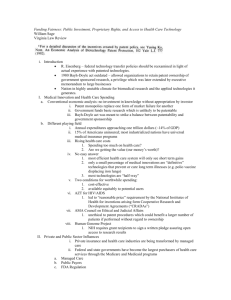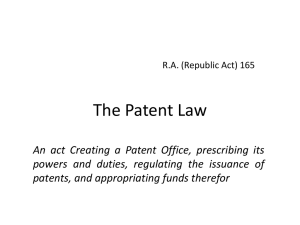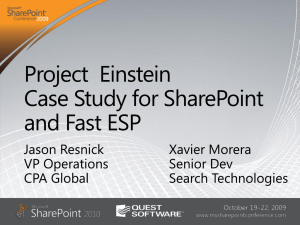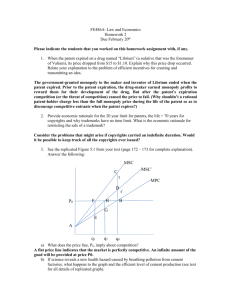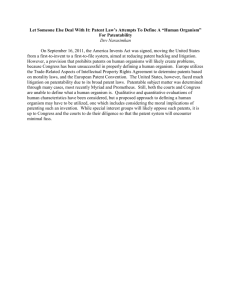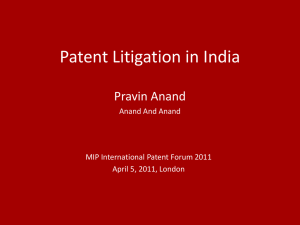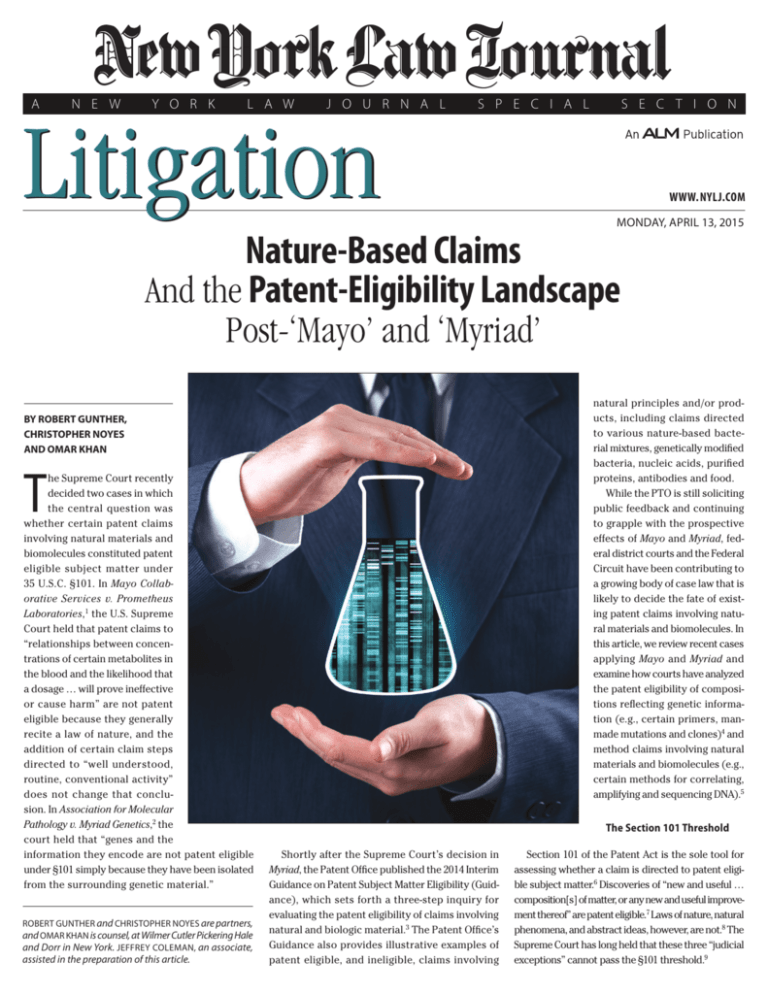
A
N E W
Y O R K
L A W
J O U R N A L
Litigation
S P E C I A L
S E C T I O N
www. NYLJ.com
Monday, April 13, 2015
Nature-Based Claims
And the Patent-Eligibility Landscape
Post-‘Mayo’ and ‘Myriad’
natural principles and/or products, including claims directed
to various nature-based bacterial mixtures, genetically modified
bacteria, nucleic acids, purified
proteins, antibodies and food.
While the PTO is still soliciting
public feedback and continuing
to grapple with the prospective
effects of Mayo and Myriad, federal district courts and the Federal
Circuit have been contributing to
a growing body of case law that is
likely to decide the fate of existing patent claims involving natural materials and biomolecules. In
this article, we review recent cases
applying Mayo and Myriad and
examine how courts have analyzed
the patent eligibility of compositions reflecting genetic information (e.g., certain primers, manmade mutations and clones)4 and
method claims involving natural
materials and biomolecules (e.g.,
certain methods for correlating,
amplifying and sequencing DNA).5
By Robert Gunther,
Christopher Noyes
and Omar Khan
T
he Supreme Court recently
decided two cases in which
the central question was
whether certain patent claims
involving natural materials and
biomolecules constituted patent
eligible subject matter under
35 U.S.C. §101. In Mayo Collaborative Services v. Prometheus
Laboratories,1 the U.S. Supreme
Court held that patent claims to
“relationships between concentrations of certain metabolites in
the blood and the likelihood that
a dosage … will prove ineffective
or cause harm” are not patent
eligible because they generally
recite a law of nature, and the
addition of certain claim steps
directed to “well understood,
routine, conventional activity”
does not change that conclusion. In Association for Molecular
Pathology v. Myriad Genetics,2 the
court held that “genes and the
information they encode are not patent eligible
under §101 simply because they have been isolated
from the surrounding genetic material.”
Robert Gunther and Christopher Noyes are partners,
and Omar Khan is counsel, at Wilmer Cutler Pickering Hale
and Dorr in New York. Jeffrey Coleman, an associate,
assisted in the preparation of this article.
The Section 101 Threshold
Shortly after the Supreme Court’s decision in
Myriad, the Patent Office published the 2014 Interim
Guidance on Patent Subject Matter Eligibility (Guidance), which sets forth a three-step inquiry for
evaluating the patent eligibility of claims involving
natural and biologic material.3 The Patent Office’s
Guidance also provides illustrative examples of
patent eligible, and ineligible, claims involving
Section 101 of the Patent Act is the sole tool for
assessing whether a claim is directed to patent eligible subject matter.6 Discoveries of “new and useful …
composition[s] of matter, or any new and useful improvement thereof” are patent eligible.7 Laws of nature, natural
phenomena, and abstract ideas, however, are not.8 The
Supreme Court has long held that these three “judicial
exceptions” cannot pass the §101 threshold.9
Monday, April 13, 2015
In Mayo, the patents at issue claimed processes
to help doctors treat patients with autoimmune
diseases and, specifically, to determine whether a
given dosage level of thiopurine drugs is too low
or too high by identifying correlations between
metabolite levels and the likelihood that the drug
would be effective The Supreme Court found that
the claims did not constitute eligible subject matter because they “set forth laws of nature—namely,
relationships between concentrations of certain
metabolites in the blood and the likelihood that
a dosage of a thiopurine drug will prove ineffective or cause harm.” The court concluded that
although the patents recited additional steps in
addition to the law of nature, the additional steps
were insufficient to transform the character of the
claims into patent-eligible subject matter, because
those steps “consist of well understood, routine,
conventional activity already engaged in by the
scientific community [which], when viewed as a
whole, add nothing significant beyond the sum
of their parts taken separately.”
The Supreme Court in Myriad faced the question of whether Myriad’s patents—which claimed
the genetic sequence of two genes involved in
breast cancer, BRCA1 and BRCA2—were directed
at “new and useful” compositions of matter, or if
they were instead directed at “naturally occurring
phenomena.” The court held that Myriad did not
create or alter any genetic information encoded in
the BRCA genes, and Myriad’s success in isolating
the genes by separating them from the genome by
breaking chemical bonds was not enough to save
the claims. Synthetically created cDNA was held
to be patent eligible, however, because its exonsonly chemical structure is not naturally occurring.
Compositions Encoding Gene Information
Primers. Primers are short sequences of synthetic DNA complementary to a specific DNA
sequence, and are used to initiate the process
known as polymerase chain reaction whereby
nucleotides are added to a growing chain of DNA.
In a follow-on case related to Myriad, the District
Court for the District of Utah held that claims to
synthetic primers having the same sequence as
human DNA were not patent eligible.10 The district
court interpreted Myriad narrowly, finding that the
claimed primers, although synthetically designed,
were not “markedly different” from naturally occurring DNA, and that synthetic DNA is patent ineligible when it reflects the same nucleotide sequence
as natural genomic DNA.11 On appeal, the Federal
Circuit agreed that “[t]he primers before us are
not distinguishable from the isolated DNA found
patent-ineligible in Myriad and are not similar to
the cDNA found to be patent-eligible,” because
they are “structurally identical to the ends of DNA
strands found in nature.” 12 The Federal Circuit
cited the Supreme Court’s reasoning from Myriad
to conclude that primers are not patent eligible
merely because they have been separated from
other genetic material. According to the court,
the functions of primers are also not fundamentally different, because “the naturally occurring
material is used to form the first step in a chain
reaction—a function that is performed because
the primer maintains the exact same nucleotide
sequence as the relevant portion of the naturally
occurring sequence.”13
Man-Made Mutations. In a portion of Myriad
that was not on appeal to the Supreme Court,
the Federal Circuit held that a claim directed to a
screening method for cancer treatment was patent
eligible under §101. The claimed process at issue
consisted of growing host cells transformed with
a mutated BRCA gene in the presence of a compound suspected of being a cancer therapeutic
while maintaining some of the transformed cells
apart from the potentially therapeutic compound,
and subsequently determining the growth rate of
the host cells in both groups by comparing growth
rates (wherein a slower growth rate of host cells in
the presence of such a compound is indicative of
a cancer therapeutic).14 In holding that this claim
covered patent-eligible subject matter, the Federal
Circuit explained that it amounted to more than
the simple application of a law of nature, since it
involved the application of certain steps to transformed, man-made cells that were not the product of nature.15 Thus, these man-made cells were
patent-eligible subject matter, and “once one has
determined that a claimed composition of matter
is patent-eligible subject matter, applying various
known types of procedures to it is not merely applying conventional steps to a law of nature.”
Clones. A clone is an identical genetic copy of a
cell, cell part, or organism. In In re Roslin Institute
(Edinburgh), the Federal Circuit addressed the
patent eligibility of “Dolly the Sheep” and other
mammals cloned using what the court described
as “a breakthrough scientific method.” Noting that
the patent claims directed to the method of cloning were not at issue, the court invalidated claims
directed to clones developed from donor mammals
because they shared exact genetic identity with the
donor.16 The court held that naturally occurring
organisms are not patent eligible subject matter
under both pre- and post-Myriad case law, even
where the cloned species is the work of human
ingenuity and not “nature’s handiwork.”
Use of Natural Materials, Biomolecules
Correlations Based on Analysis of Drug
Metabolites. In Ameritox v. Millenium Health, the
method claims at issue involved, in part, “detecting,” “normalizing,” and “quantifying” the amount
of drug metabolites in a urine sample.17 In denying
defendant’s motion for summary judgment, the
court explained that while each of the steps in the
claimed method involved “conventional” scientific
techniques, the “combination” of each of these steps
produced “a new and useful result.” In contrast to
Mayo, in which the court found that “at least the
combination of those steps, were in context obvious, already in use, or purely conventional,” the
district court in Ameritox noted that the defendant
could not point to any “reference demonstrating
the existence of or even suggesting the combination
of the comparative step with the additional steps
of the invention.” Because nothing in the prior art
suggested that such a combination was well-known,
the method claim passed muster under §101 in light
of Myriad and Mayo.
Correlations Based on Genetic Analysis. A
number of decisions have addressed patent claims
directed to analyzing the correlations between certain conditions, including disease conditions, and
the presence (or absence) of a genetic marker. The
Federal Circuit in Myriad found that certain method
claims at issue were patent ineligible under §101.
Most of those claims involved “comparing” or “analyzing” a patient’s BRCA sequence with the normal,
or “wild-type,” sequence to identify the presence
of cancer-predisposing mutations.18 The court concluded that these claims were not directed to patenteligible subject matter because they “recite[] nothing
more than the abstract mental steps necessary to”
compare or analyze different nucleotide sequences.19
In PerkinElmer v. Intema, the claims were directed
to specific screening methods to estimate the risk of
fetal Down syndrome, using markers from the first
and second trimesters of pregnancy.20 The claim at
issue covered a multi-step method of: (1) measuring
the levels of certain biological markers from both
the first and second trimester of pregnancy; and
(2) determining whether an increased risk of Down
syndrome existed by comparing those markers.21
The court in PerkinElmer held that the claims recited
patent-ineligible subject matter under §101 because
the steps only instructed the user “to engage in wellunderstood, routine, conventional activity previously
engaged in by scientists who work in the field.”
In Genetic Technologies v. Laboratory Corporation
of America Holdings, the court considered a method claim drawn to predicting “potential sprinting,
strength, or power performance” in elite athletes by
Monday, April 13, 2015
“analyzing a sample” for the presence of a specific
gene, “detecting” the presence of two specific alleles,
and using those analytics to “predict” athletic performance was held invalid under §101.22 The claim
was found patent ineligible, because the “analyzing,”
“detecting,” and “predicting” steps simply tell users
to apply the natural law and do not add anything
to allow the process to qualify as patent eligible.
Amplifying and Detecting DNA. Courts have
also addressed claims that, in addition to correlation steps, also require certain steps involving
amplifying, sequencing and/or hybridizing DNA. In
Ariosa Diagnostics v. Sequenom, for example, the
district court analyzed patent claims directed to
certain methods of amplifying and detecting cell-free
fetal DNA (cffDNA). The parties agreed that neither
cffDNA nor the discovery of cffDNA in maternal
plasma or serum was patentable, because the presence of cffDNA in maternal plasma or serum is a
natural phenomenon. The issue before the court
was whether method claims reciting the steps of
“amplifying a paternally inherited nucleic acid from
the serum or plasma sample” and “detecting the
presence of a paternally inherited nucleic acid of
fetal origin in the sample” were patent eligible.23 The
court held they were not, finding that the claimed
processes at issue—apart from the natural phenomenon of paternally inherited cffDNA—involve
no more than well-understood, routine, conventional activity, previously engaged in by those in
the field. In addition, the court considered whether
the claims posed a risk “of preempting a law of
nature, natural phenomenon, or abstract idea,” and
found that they did because alternative methods for
detecting cffDNA were “not commercially viable”
and “the effect of the patent in practice would be
to preempt all uses of the natural phenomenon.”
In other cases—Genetic Technologies v. Agilent
Technologies24 and Genetic Technologies v. BristolMyers Squibb25—two different courts considered
a method claim involving “amplifying genomic
DNA with a primer pair that spans a non-coding
region sequence” and then “analyzing the amplified sequence to detect the [target].”26 In Agilent,
the court held that the claim was arguably limited
to a patentable application of natural law, noting
that “the application of primer pair amplification
to intron sequences … may well have been ‘novel
and unconventional’ [and] whether those in the field
would consider applying genomic amplification to
non-coding regions conventional or routine is a factual question better addressed at a later stage.” In
Bristol-Myers, however, the court concluded that “the
‘amplifying’ step is insufficient to meaningfully limit
the claims” because “the ‘said primer pair’ limitation
merely recites the natural phenomenon itself—the
linkage correlation—just as the ‘wherein’ steps in
Mayo recited the characteristics of the metabolite
correlations.” The court in Bristol-Myers concluded
that the “primer-pair” limitation merely “sets forth
a condition that is inherently required in order to
implement the natural law and, therefore, does nothing to impart an ‘inventive concept.’”
Sequencing and Hybridizing DNA. Similarly,
in University of Utah Research Foundation v. Ambry
Genetics, the court concluded that certain method claims involving the use of BRCA1 or BRCA2
sequences were not patent eligible, where the only
“inventive concepts” in the claims at issue were the
patent ineligible naturally occurring BRCA1 and
BRCA2 sequences themselves.27 The court found
that the claimed steps relating to “DNA amplification, sequencing, comparisons, detecting alterations in sequences, [] hybridizing probes to alleles”
and “designing or using probes, primers, or arrays”
were merely “conventional activities that were wellunderstood and uniformly employed by those working with DNA.” Because the claims covered the use
of PCR, “the most widely used means to amplify
DNA,” the court held that the claims preempted
the field as they would “effectively construct a wall
around the naturally occurring BRCA1 and BRCA2
genetic sequences.”
Conclusion
Following the Supreme Court’s decisions in Mayo
and Myriad, federal courts have analyzed the patent
eligibility of certain nature-based claims, including
claims directed to compositions reflecting genetic
information (e.g., certain primers, man-made mutations and clones) and method claims involving natural materials and biomolecules (e.g., certain methods
for correlating, amplifying and sequencing DNA). As
the PTO’s Guidance document demonstrates, however, there are numerous other types of nature-based
claims—including claims directed to certain bacterial mixtures, genetically modified bacteria, purified
proteins and antibodies—many of which are likely
to be litigated at both the Patent Office and in the
courts in the years to come.
••••••••••••••••
•••••••••••••
1. Mayo Collaborative Servs. v. Prometheus Labs., 132 S. Ct.
1289, 1296 (2012).
2. 133 S. Ct. 2107, 2120 (2013).
3. 79 Fed. Reg. 74618-33 (Dec. 16, 2014) (to be codified at 37
C.F.R. pt. 1). The Guidance directs patent examiners to determine whether the claim is directed to a process, or composition of matter. If it is, examiners must determine if the claim
is directed to a law of nature or natural phenomenon. For nature based products to meet eligibility criteria, the claim must
recite elements that amount to “significantly more” than the
natural product or law of nature.
4. See Univ. of Utah Research Found. v. Ambry Genetics
(In re BRCA1- & BRCA2- Based Hereditary Cancer Test Patent
Litig.), 3 F. Supp. 3d 1213 (D. Utah 2014); In re Roslin Inst. (Edinburgh), 750 F.3d 1333 (Fed. Cir. 2014); In re Bentwich, 566 F.
App’x 941 (Fed. Cir. 2014).
5. See Ambry Genetics, 3 F. Supp. 3d 1213; Genetic Techs.
v. Lab. Corp. of Am. Holdings, 2014 U.S. Dist. LEXIS 122780 (D.
Del. Sept. 3, 2014); Genetic Techs. v. Bristol-Myers Squibb, 2014
U.S. Dist. LEXIS 154443 (D. Del. Oct. 30, 2014); Genetic Techs. v.
Agilent Techs., 24 F. Supp. 3d 922 (N.D. Cal. 2014); Ariosa Diagnostics v. Sequenom, 19 F. Supp. 3d 938 (N.D. Cal. 2013).
6. 133 S. Ct. at 2116.
7. 35 U.S.C. §101 (2012).
8. 133 S. Ct. at 2116.
9. Id.
10. See Univ. of Utah Research Found. v. Ambry Genetics, 3 F.
Supp. 3d 1213, 1266 (D. Utah 2014), aff’d, 774 F.3d 755, 761 (Fed.
Cir. 2014). The claim at issue recited:
A pair of single-stranded DNA primers for determination of a nucleotide sequence of a BRCA1 gene by
a polymerase chain reaction, the sequence of said
primers being derived from human chromosome 17q,
wherein the use of said primers in a polymerase chain
reaction results in the synthesis of DNA having all or
part of the sequence of the BRCA1 gene.
11. 3 F. Supp. 3d at 1260-62.
12. 774 F.3d at 760.
13. Id. at 761.
14. Ass’n for Molecular Pathology v. U.S. Patent & Trademark
Office, 689 F.3d 1303, 1310 (Fed. Cir. 2012) aff’d in part, rev’d in
part sub nom. Ass’n for Molecular Pathology v. Myriad Genetics, 133 S. Ct. 2107 (2013).
15. Id. at 1336.
16. 750 F.3d 1333 (Fed. Cir. 2014). A claim at issue recited:
“A live-born clone of a pre-existing, non-embryonic, donor
mammal, wherein the mammal is selected from cattle, sheep,
pigs, and goats.”
17. 2015 WL 728501, at *26 (W.D. Wis. Feb. 19, 2015). The
claim at issue recited:
A method for quantifying at least one metabolite in a
biological sample comprising the steps of … providing
one biological sample … providing one set of known
normative data specific to a reference metabolite …
contacting the biological sample with an analytical
device … detecting the presence of at least one test
metabolite in the biological sample with the device …
normalizing the biological sample … and quantifying
the concentration of at least one test metabolite in the
biological sample by comparing a ratio between the
concentration of the test metabolite from the patient
to the set of known normative data specific to the reference metabolite concentration.
18. 689 F.3d at 1309.
19. Id. at 1334.
20. 496 F. App’x 65, 66 (Fed. Cir. 2012).
21. Id. at 71.
22. 2014 U.S. Dist. LEXIS 122780, at *40-41. A claim at issue recited:
A method to predict potential sprinting, strength, or
power performance in a human comprising: … predicting the potential sprinting, strength, or power performance of the human, wherein the presence of two
copies of the 577R allele is positively associated with
potential sprinting, strength, or power performance.
23. Ariosa Diagnostics v. Sequenom, 19 F. Supp. 3d 938, 941
(N.D. Cal. 2013). A representative claim at issue recited:
A method for detecting a paternally inherited nucleic
acid of fetal origin performed on a maternal serum or
plasma sample from a pregnant female, which method
comprises amplifying a paternally inherited nucleic
acid from the serum or plasma sample and detecting
the presence of a paternally inherited nucleic acid of
fetal origin in the sample.”
24. 24 F. Supp. 3d 922 (N.D. Cal. 2014).
25. 2014 U.S. Dist. LEXIS 154443 (D. Del. Oct. 30, 2014).
26. 24 F. Supp. 3d at 926. The claim at issue recited:
A method for detection of at least one coding region
allele of a multi-allelic genetic locus comprising … amplifying genomic DNA with a primer pair that spans a
non-coding region sequence … and … analyzing the
amplified DNA sequence to detect the allele.
27. 3 F. Supp. 3d at 1269. The claim at issue recited:
A method for screening germline of a human subject
for an alteration of a BRCA1 gene which comprises
comparing germline sequence of a BRCA1 gene or
BRCA1 RNA from a tissue sample from said subject or
a sequence of BRCA1 cDNA made from mRNA from said
sample with germline sequences of wild-type BRCA1
gene, wild-type BRCA1 RNA or wild-type BRCA1 cDNA,
wherein a difference in the sequence of the BRCA1
gene, BRCA1 RNA or BRCA1 cDNA of the subject from
wild-type indicates an alteration in the BRCA1 gene in
said subject.
Reprinted with permission from the April 13, 2015 edition of the NEW YORK
LAW JOURNAL © 2015 ALM Media Properties, LLC. All rights reserved. Further
duplication without permission is prohibited. For information, contact 877-257-3382
or reprints@alm.com. # 070-04-15-18

